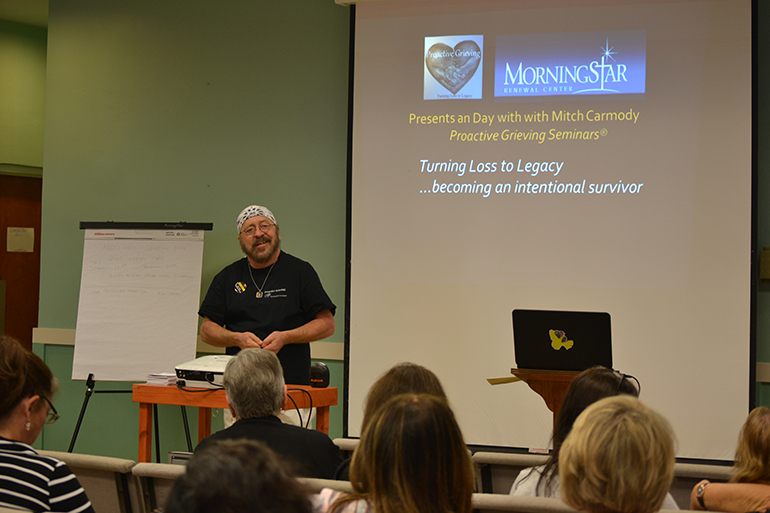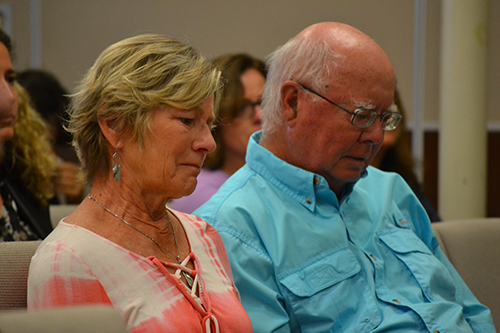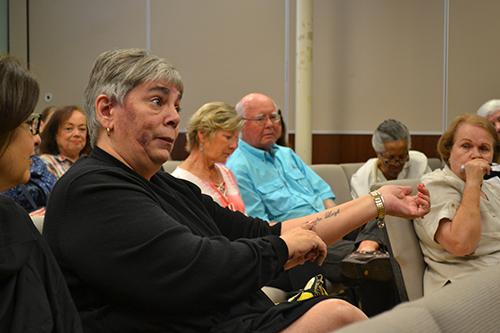By Priscilla A. Greear - Florida Catholic

Photographer: MONICA LAUZURIQUE | FC
Mitch Carmody shares his methods of dealing with grief during the seminar at MorningStar Renewal Center.
PINECREST | Mitch Carmody’s 9-year-old son, Kelly, died tragically of brain cancer. But his deceased child’s spirit lives on in his family nearly 30 years later, and his portrait hangs in the front hall of his home in Minnesota.
The Catholic artist, speaker and grief facilitator used to say that he had a son. “Now I say, ‘I have a son, his name is Kelly. He died,’” said Carmody, author of “Letters to My Son.”
“We still have his picture on our wall. Now my grandkids say, ‘Hi, Uncle Kelly.’ They’ve grown up with death as a part of life. We’ve never let Kelly go.”
With bittersweet humor and empathy, Carmody shared wisdom gleaned from his experiences of death during a two-day seminar last month at the MorningStar Renewal Center in Pinecrest. Organizers hope to use the seminar to jump-start the bereavement ministry across the Miami Archdiocese.

Photographer: MONICA LAUZURIQUE | FC
Kathy and Bob Heger traveled from Boca Raton to attend the coping with grief seminar at MorningStar Renewal Center in Pinecrest.
“I’m extremely happy and excited to have had this program and look forward to our next steps in growing bereavement ministry in churches,” said Sue DeFerrari, MorningStar director of ministry.
In the opening talk, Carmody touched on myriad topics, including survival strategies for healing and living loss constructively as a form of legacy. Many of those in attendance were from Compassionate Friends of Miami, part of a network of over 700 nondenominational support groups for those grieving the death of a sibling, child or grandchild. Students studying spiritual direction at St. Thomas University also participated.
Carmody’s father died when he was 14. He said he bottled up his feelings and looked after his siblings. When his brother with cerebral palsy died, he quickly found an Irish priest near the institution where he had lived and arranged the funeral � followed by a wake at a bar. Later, his born-again Christian twin sister died in an accident. That funeral focused on coming to Jesus.
“First one I didn’t talk about it. The second I had a drunken party and now we’re having a church meeting,” he recounted.
Twenty Faces of GriefOnly six months after his sister’s death, his son was diagnosed. After his death, Carmody went through five vapid years of gray. But when Mother Teresa died he was inspired to draw her image for a church fundraiser. Then he started drawing pictures of mourning stages, creating the Twenty Faces of Grief, ranging from anguish to depression to confusion, which he shared with the seminar participants.
Carmody found solace in gradually giving 40 gallons of blood. “The more you give yourself to others and help other people it helps so much,” he said. “I did it as a legacy to Kelly. And it was really selfish to me early on because the only thing that made me feel better was to give blood.”
One drawing was entitled “loneliness.”
“Thank God it won’t go away. If it did how would we handle that? We’ll always miss our loved one,” he said. “There is no closure. It’s just living with.”
‘Get it out’Mourners also need to find physical ways to “get it out,” Carmody continued, noting that tears release the stress-related cortisol hormone and sweat removes toxins. It’s also “so important” to breathe deeply.
“Whether chopping wood, busting a plate or crying, it’s letting the body do its thing,” he said. “We stop breathing, our shoulders go up and we’re going into that fetal response.”
He encouraged his listeners to live with gratitude for the time with deceased loved ones, tell family members they love them and write a bucket list. And as a Catholic, “the faith piece is huge,” he added. “My faith is I know my son lives on in another realm of existence and I’m going to join some him day.”
Participants at the seminar also share their own coping strategies.

Photographer: MONICA LAUZURIQUE | FC
Donna Langer, who came from Fort Myers, shows a tattoo she he has on her arm with the name of her deceased daughter, Jennifer Pope.
Dermatologist Dr. Juana Julien lost her three children and husband in a car accident in 2005. Patients often asked her how she survived. “I would tell them the truth. It’s very painful and the pain is not going to go away and you need to cry when you need to cry. But I’d tell them all the tools in my Catholicism that helped me enormously � the Virgin Mother and her pain, the wisdom of the saints. The Eucharist was my life’s blood. It was more important to me than food and air. Exercise...” she said.
Furthermore, “you have to focus on who around you still needs you, who around you do you still need to love. And that’s what made me go back to work.”
Group supportShe also affirmed the value of group support. “When you’re in one of these groups I think it’s relieving to know other people have known death closely too and you’re not an odd ball. Because the way society is, death is sort of not talked about and put in a corner,” she reflected.
Guilt is often a part of the grief process. Carmody spoke of one man who rolled onto his three-month-old next and suffocated him. He now speaks publicly against co-sleeping.
“He didn’t want to torture himself anymore. He couldn’t change it so he said maybe I can change other things,” said Carmody.
That would be the “R” in Carmody’s S.T.A.I.R.S. model that grievers climb. “S” stands for the shock or numbness. “T” is for trauma of living without loved ones. “A” is for acceptance of the challenge to survive. “I” is for introspection, “R” for reinvestment and “S” for serenity.
Introspection involves doing a personal inventory of gifts. “I have things that I can do that I’ve never been called on to do but I have to now I’m in the pit of despair,” he said. “I’m going to take emotional risks that I never took before because what could hurt me any more than I’ve been hurt... So you reinvest in life with a whole different perspective and rejuvenate your life and then can you hit serenity.”
Between loss and loveCindy Baum, a co-leader with Shelly Ellis of Compassionate Friends, lost her son 15 years ago. “It’s under the surface. I learn to co-exist between the loss and the love.”
Baum said that “some find faith as a tremendous help and others are angry� We don’t tell people what they should or shouldn’t do. Most will find their way back to religion or spirituality.”
Ellis added that group members rediscover joy as they talk about the loved one’s death and remember the life. “People tend to feel guilty when they smile or laugh and that’s very important to see; if (another member) can do that at some point I’ll be able to do that.”
DeFerrari also experienced the death of a son and has met many grievers needing support over the years. “Our faith is a tool. Our faith is our strength. Our faith promises life after death where we can bring that very real hope of what we believe as Catholics to the process of grief.”
She envisions the seminar as “a first step to open up dialogue.”
“Hopefully this can be a springboard for us to develop some kind of program where we can invite people from different parishes who might have an interest in and can be trained to start small bereavement ministries in their church,” she said. “We have a place in our churches for faith-based bereavement groups � not counseling but support, prayer, fellowship, and a place to come to know you’re not the only one this has happened to. You don’t have to share your story but you can listen.”

